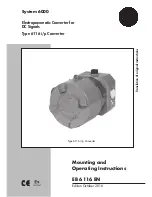
ELCART
ELCART DISTRIBUTION SPA via Michelangelo Buonarroti, 46 - 20093 Cologno Monzese (Milano) ITALY
Tel. +39 02.25117310 Fax +39 02.25117610 sito internet: www.elcart.com e-mail: [email protected]
Manuale di istruzioni/Scheda tecnica
La divulgazione dei dati contenuti in questa scheda è da ritenersi un servizio puramente informativo e non costituisce alcun vincolo da parte della Elcart in merito a prestazioni ed utilizzo del prodotto.
The divulgation of data contained on this technical sheet are exclusively for informational reasons and establish no link on behalf of Elcart regard to thr performances and the usa of the product.
La divulgacion de los datos contenidos en esta ficha son un servicio unicamente informativo y no constituyen ningun vinculo de parte de Elcart respecto a las prestaciones y uso del producto.
ART. 13/16600 - 13/16610
PAGINA 10 DI 12
3.2. Load …….. Caution: Please don’t operate this inverter with load in excess of 2500W or full load for extended period of time to avoid overload
or over temperature.
4. Permanent installation:
4.1. Where to install …..
The inverter should be installed in a location that meets the following requirements:
a. Dry: Don’t allow water to drip or splash on the inverter.
b. cool: Ambient air temperature should be kept between 0 ~ 25°C (32 ~ 77°F)
c. Ventilated: ensure that the inverter in a compartment which is ventilated and you need to allow at least 1 inch (2.54 cm)
of clearance around the inverter for air flow. Ensure that ventilation openings one the output panel and input panel aren’t obstructed.
Caution: For reduce the fire hazard and avoid the overheating, please don’t cover or obstruct ventilation openings of the inverter.
And don’t put it in a zero clearance compartment.
d. Safe: Don’t install the inverter in the same compartment of storing flammable matters such as gasoline, gas, nitroglycerin, ………. etc.
e. Close to battery: install the inverter as close to battery as possible in order to minimize the length of DC cables, but don’t put in the same compartment.
It is better and cheaper to run loner AC wires than longer DC cables, because of the much lower current is the AC wires.
Caution: Some components of the inverter tend to produce arcs or sparks, for reduce risk of fire and explosion, please don’t install the in verter in
the compartment containing batteries and flammable matters and flammable matters.
4.2. How to install
….. Mount the inverter horizontally or vertically on a flat surface using the mounting flanges on the output panel and input panel.
Mounting hardware should be corrosion resistance and larger. Never drop the inverter as it is a sensitive electrical product and
damage will occurs.
4.3. Battery recommended
…….. The battery you use strongly affects the performance you can expect from the inverter, it is very important to correct
size and type of battery.
4.4. DC cable recommended
…….. Proper wire and wiring is very important for the safe and proper operating of the inverter.
Because the 2500W inverter has a low voltage, high current input, low resistance wiring between the battery and the inverter
is essential to deliver the maximum amount of usable energy to your load.
Don’t waste the investment you have made in batteries and a highly efficient inverter by using undersized wires.
2500W/12V : #38
2Awg
2500W/24V : #22
4Awg
Caution : Don’t tin the cable ends with solder owing to it will result in a poor connection .
5. Maintenance
……..
For always keep the inverter operating normally, please clean the exterior of the unit periodically with a alcoholic cloth
(or damp cloth) to prevent accumulation of dust and dirt. The air intake (fan/ventilation openings) on the input panel and air exhaust
slots on the output panel is especially prone to accumulate dust and dirt.
A regular maintenance check is recommended, and the screws on the DC input terminals shoud be tightened periodically.
6. Trouble shooting guide :
1. Low voltage output
Using an average reading voltmeter Use true RMS reading meter
2. Low voltage output and
AMPS indicator in red zone
Overload
Reduce
load
3. No voltage output and VOLTS
indicator in lower red zone
Low voltage input
Recharge battery, check connections and cable
a.
b.
c. Internal fuse open
Have qualified electrician to check and replace
4. No voltage output and
POWER indicator no light
d. Reverse DC polarity
Have qualified electrician to check replace fuse,
please observe correct polarity
5. No voltage output and VOLTS
indicator in upper red zone
High voltage input
Make sure that inverter is connected to 12V battery
(24V for 2500W/24V inverter) and check regulation of charging system
6. Low battery alarm on all the time
and VOLTS indicator below 10.5V
(21V for 2500W/24V inverter)
a. poor DC wiring
Use proper cable and make solid connections
Change battery or use new battery
Poor battery condition
b
7. No voltage output, OVER TEMP
indicator light and load in excess of
2500W/250A current input
(or 125A for 2500W/24V inverter)
Thermal shutdown
Allow inverter cool down and reduce
load if continuous operation required
8. No voltage output, OVER TEMP
indicator light and load less than
2500W/250 A current input
(or 125A for 2500W/24V inverter)
Thermal shutdown
Make sure ventilation openings in
inverter obstructed and reduce ambient temperature.
9. No voltage output and OVER LOAD
indicator light
a. Short circuit or wiring
error
Check AC wiring for short circuit or
improper polarity
Caution: If after the above easy troubleshooting, this inverter still doesn’t work, please return it to us or have a qualified electrician to check and replace.
Don’t open the case or cut out the cord br youself.
No power to inverter
Check wiring to inverter and battery
Inverter switched off
Turn inverter on
Problems
Possible causes
Solutions






























